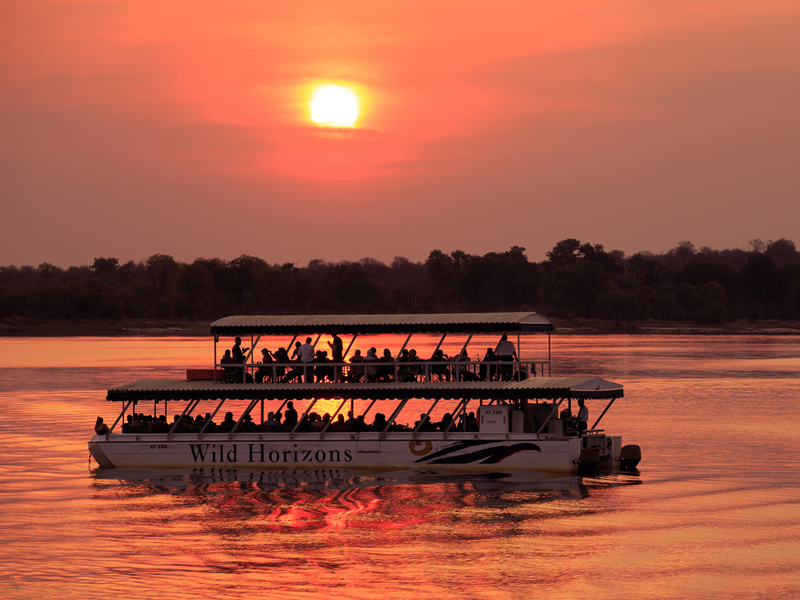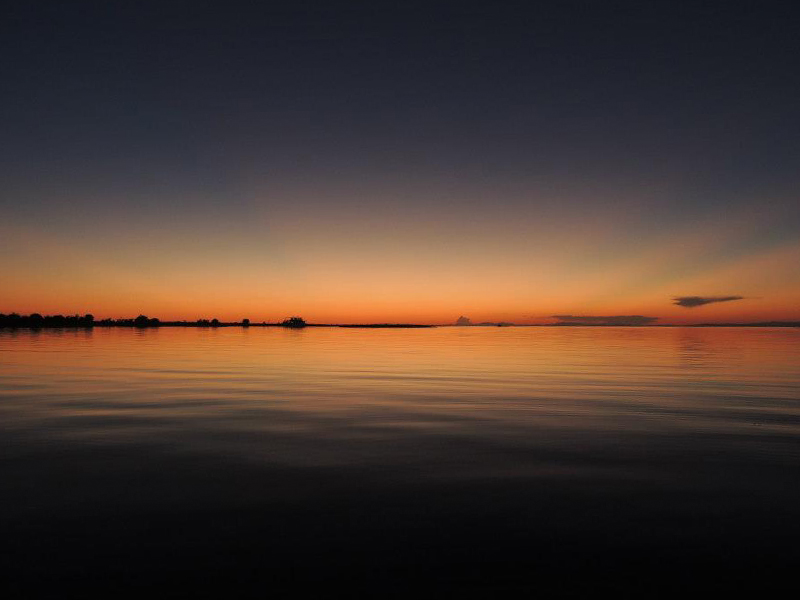Points of Interest
Hwange National Park
Roughly the size of Wales, Hwange is Zimbabwe’s largest National Park and boasts huge concentrations of elephants. The park has no rivers, but natural pans and streams form in the wet season and other man made waterholes provide a refuge for its inhabitants during the dry season. Most of the park is navigated by dirt roads and even in its peak season is not overcome with so many tourist to take away from its raw beauty. In addition to over 25,000 elephants, Hwange is also home to impressive herds of buffalo, lion, cheetah and sighting of leopard. Its plain’s game is plentiful with giraffe, impala, zebra, wildebeest and kudu often seen on game drives. There are a few private concessions within the park that operate walking safaris. The landscape changes from vast open vleis (riverbeds) and grassy plains in the southern part of the park, to rocky outcrops and thick Mopane and Acacia forest in the central and northern regions.
Victoria Falls
This lively, bustling town, which is full of spirit is a must for visitors to Zimbabwe and neighboring countries. The star attraction is of course the Victoria Falls, a natural phenomenon where the Mighty Zambezi River cascades over a crevasse 1,688m wide falling 100m before zig-zagging its way through the narrow Mupata Gorge. Victoria Falls town offers guests the opportunity to tick this Natural Wonder of the World off their bucket list, test their courage on some of Africas most intense adrenaline activities, and experience the fascinating culture and history of the country, all whilst being in close proximity to the bush and wildlife.
In recent years this town has invested in upgrading hotels and building new and eccentric restaurants, bars, coffee shops and breweries, so guests are sure to enjoy themselves and fill their time with once in a lifetime experiences.
Mana Pools National Park and The Lower Zambezi River
Mana Pools National Park is located on Zimbabwe’s northeastern region, along the ancient Lower Zambezi River which forms the border between Zimbabwe and Zambia. Positioned north of the Zimbabwe escarpment, a massive mountain range that gives way to a vast and open floodplain leading to the river. “Mana” meaning “four” in the local Shona language describe the inland pools of water that were formed by the river. Most Mana Pools operators shut their lodges down during the wet season as the rains make most areas inaccessible. It is truly a wild place where visitors during the dry season are almost guaranteed an up close and personal sighting of lions, hyena or wild dog. Most of the terrain along the river is characterized by tall mahogany and acacia trees where elephants are often seen reaching high into their branches on two legs. Walking safaris are allowed in Mana and is a highlight of safaris in the area, but only recommended if you are in the presence of a professional guide. Overall, a superb game viewing park with the stunning backdrop of the Zambezi River and the Zambian escarpment in the distance.
For the more adventurous who want to experience more of the Lower Zambezi River and all its wonder, a new operation has recently been developed taking guests on “floating safaris” which begin 70 kilometers upstream from Mana Pools, passing Mana Pools en route and carrying on a further 100 downstream near the Mozambique border. An exciting and unique way to take in this extraordinary part of Africa.
Matobo Hills National Park
Although Matobo Hills is one of the country’s smaller parks, within its boundary is a world of mystery, culture, and a larger than life landscape. It is a place that can’t quite be described as its impact is more of a feeling, a spiritual place rather than a wildlife safari destination. Matobo meaning “bald heads” in the local language, describes the massive rocky outcrops or “balancing rocks” that characterize the entire landscape of the park. Granite boulders that seem to defy nature, tower above the remarkable diverse wooded valleys below. The hills and caves of this park were once the homes of San Bushman and is evident in the over 3,000 year old bushman paintings scattered throughout the park. Matobo Hills is also the resting place of Cecil John Rhodes the adventurist and opportunist who fell in love with this part of the world in the early days of exploration. Not only does Matobo Hills have the largest concentration of eagles, but it is also an Intensive Protection Zone for the endangered black and white rhino. After a trip to the Matobo Hills, at the end of a safari, you can complete the Big Five checklist while being offered a place of solitude to relax, unwind and reflect on your safari.
Lake Kariba and the Matusadona National Park
Lake Kariba is the name given to one of the largest man made lakes on the planet. It is a dammed off portion of the Zambezi River providing hydro electric power for much of Zimbabwe and southern Zambia. This huge body of water extending roughly 280kms long and up to 40kms wide resembles that of a small ocean than a lake. It has become a popular holiday attraction for guests to spend a few nights on a private houseboat that meanders through the lake’s vast and encompassing waters. Sunsets on lake Kariba are second to none and when the lake is placid, it acts as a perfect mirror image of the vibrant colors above that only nature can create. Fishing is also an enjoyable activity on the lake, where anglers can reel in the likes of tiger fish, giant vundu, bream and chessa.
For those who prefer to be on land, there are a few stunning lodges located on the southern shores of the lake, in and around the Matusadona National Park, where land-based and boating activities are offered. Plentiful game such as elephant, lion, buffalo, leopard, cheetah and wild dog can be spotted.
Gonarezhou National Park
Gonarezhou meaning “place of many elephants” is exactly that, and so much more. This recently classified Wilderness Park lies undisturbed in the remote southeast corner of Zimbabwe. Known by many, but visited by few, this park in our opinion epitomizes the true African wild. With the Kruger National Park across the border to the south and the Gaza area in Mozambique to the east, there is very little development surrounding this park. Accommodation is also limited to just one luxury lodge outside the park, mobile walking safaris, and a few chalets and designated camping areas run by National Parks within the boundary. As intimidating as this may be for the inexperienced traveller, it only means that there are very few chances of running into other tourists, even though this park has much to offer.
The Chilojo Cliffs in the central northern section of the park, tower over 350 meters above the Runde River and offers spectacular views both when observing from the northern banks of the river and from the viewpoints on top of its grand summit.
Buffalo, zebra and the rare nyala are often found near the floodplains of the Runde, as well as a single herd of Roan antelope, a species rarely seen anywhere else in the region, which started small but has now increased in Gonarezhou.
The not-so-distant roars of lions in the area both alarm and excite the wondering minds of any who recognise that resounding call. Other predators found in the park include cheetah, leopard and wild dog. The park hosts some magnificent inland pans providing a paradise for abundant waterfowl. The Runde river, which runs through the center of the park is the only other place in the country where you can catch the feisty tiger fish.
Seasonal Information
The dry season is the country’s most visited time of year as it is the best time for game viewing in all of the parks. However, the green season mustn’t be overlooked as the rains bring a beautiful change to the landscape and although game viewing is more difficult due to the thick bush, its common to see herbivores and their newborn young – followed by predators.
January – April: Rainy Season (Summer)
A daily afternoon shower is excepted as the humidity during the rainy season can be mild or torrential, especially in the months of January and February. Temperatures can reach up to 40 degrees in the earlier months.
May – June: Beginning of the dry season
Typically by May the rains have subsided apart from an occasional shower or two. Temperatures begin to drop so a light jacket is recommended for early morning game drives. By mid-day the temperatures rise to a pleasant 25 degrees.
July-August: Dry Season (Winter)
By July the temperatures have dropped and will stay below 25 degrees during the day in most areas. Mornings and evenings are quite cool, with no chance of rain.
September-October: Dry Season (Coming into Summer)
Temperature is on the rise by September, but still pleasant during the day. October is the countries hottest month, with little chance of rain, it can get slightly uncomfortable in the heat of the day, but it’s also the best time for game viewing
November-December: Beginning of the wet season
November tends to be an ambiguous month as it could still be hot and dry, but if the rains come early, the dry landscape is refreshed and new fauna spring to life. By December the rains have settled in for the season. High humidity and warm temperatures.
Zimbabwe's Wildlife
All of the Big Five are found in Zimbabwe, but not within one park or area so it is recommended to visit more than one park on safari. With nearly every opportunity at viewing wildlife – game drives, walking safaris, canoeing, kayaking, boating, helicopter – Zimbabwe is an excellent destination for game viewing. Lion, leopard, buffalo, hippo, crocs, impala and other antelope, zebra, wildebeest, giraffe, wild dog, and cheetah, can all be found in the parks in Zim.



